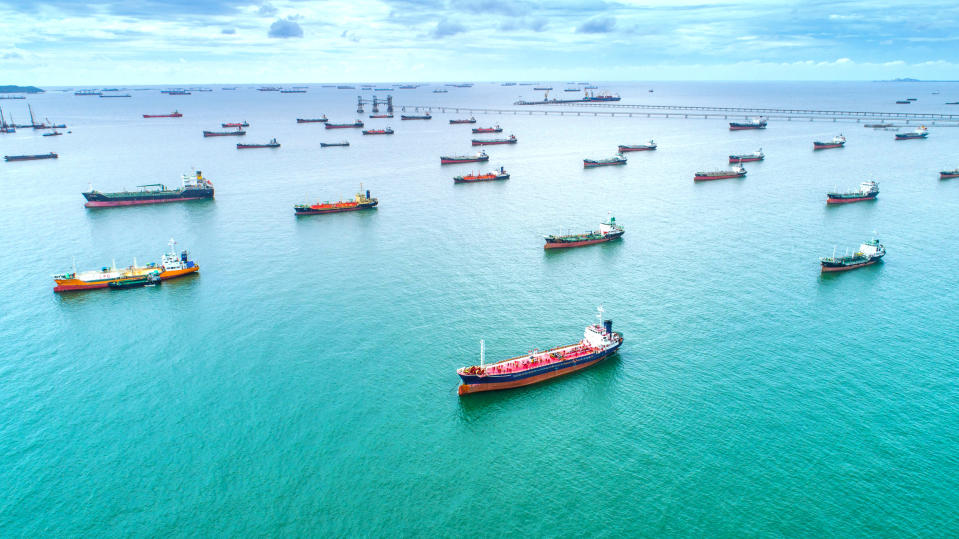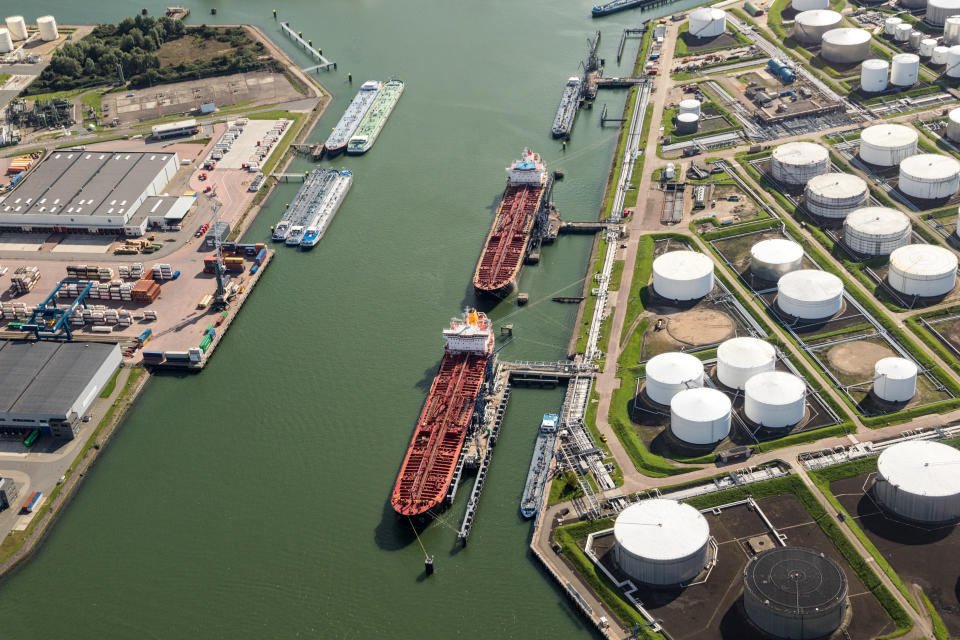Enterprise Products Partners Is Working to Solve What Could Become an Overwhelming Problem
Oil and gas companies in the U.S. have unleashed a torrent of production that has overwhelmed much of the nation's existing midstream infrastructure. That's forcing pipeline companies to work as fast as they can to build the assets needed to move all this oil and gas from production basins to market centers along the U.S. Gulf Coast.
One company racing to solve this logistical issue is Enterprise Products Partners (NYSE: EPD). The company currently has several export terminals under construction and in development, which will help move the continued flood of production to world markets. However, with output growing faster than companies like Enterprise can keep up, the coming gusher could overwhelm two key Texas ports, which has the industry starting to look elsewhere.

Image source: Getty Images.
A staggering surge of oil and gas
Last year, the U.S. oil industry delivered record-smashing oil production growth. Crude output expanded by 1.6 million barrels per day (BPD), the largest increase in the country's history, pushing oil volumes up to an average of 10.9 million BPD and obliterating the record of 9.6 million BPD set in 1970. Production is on track to continue growing at a fast pace and is expected to an average of 12.3 million BPD this year before topping 13 million BPD by 2020, according to the latest forecast from the U.S. Energy Information Administration. Meanwhile, gas production is also on track to expand at an accelerated pace over the next few years.
The bulk of this output is all flowing toward the Gulf Coast, which is the country's refining and petrochemicals hub. However, the U.S. is currently producing more oil and gas than its existing downstream infrastructure can handle, which is driving a big uptick in exports. That's also becoming problematic because those terminals are quickly filling to the brim. That led Enterprise Products Partners CEO Jim Teague to comment at a recent industry conference:
Corpus Christi can't handle what's coming, and Houston can't handle what's coming. ... It's not just crude. It's not just LNG. It's all of the above.
That's leading the company and its peers to look for ways to get out ahead of this problem by building new export-related infrastructure away from these increasingly congested areas.

Image source: Getty Images.
Shifting the focus of the export infrastructure building boom
Enterprise Products Partners already has several export projects under way and in development. The company is currently expanding the capacity of its industry-leading liquified petroleum gas terminal on the Houston Ship Channel by 30%. That project should come online during the third quarter of this year. In addition, the company is building an ethylene export terminal, which is a petrochemical made from ethane. The company expects to finish this project, also on the Houston Ship Channel, by year's end.
However, with ship traffic in Houston becoming increasingly congested as export capacity increases, the industry needs to start building elsewhere so that the region isn't overwhelmed. Enterprise is working on taking a step in that direction by proposing to construct the Sea Port Oil Terminal, which it would build 40 miles off the coast of Freeport, Texas. By developing this port offshore, Enterprise could fully load very large crude carriers capable of transporting 2 million barrels of oil, which are too big for inland ports to handle.
It's not the only company looking to build oil export facilities away from inland ports in Texas. Energy infrastructure giants Kinder Morgan (NYSE: KMI) and Enbridge (NYSE: ENB) have also proposed constructing an offshore oil terminal near Freeport, while Tallgrass Energy wants to build an onshore oil export facility in Louisiana.
In addition to going offshore, Enterprise has also said it's looking at export projects on both the East and West Coasts. Several peers have already built export terminals on the East Coast, with Kinder Morgan and Dominion Energy constructing LNG facilities while Energy Transfer operates the Marcus Hook terminal that exports natural gas liquids. Meanwhile, several companies are working on LNG export facilities from the West Coast of both the U.S. and Canada, including Pembina Pipeline, which hopes to give its Jordan Cove project in Oregon the green light later this year. Given the increasing concerns with bottlenecks along the Texas Gulf Coast, Enterprise and others are likely to propose building solutions to move oil and natural gas toward the East and West coasts, which would make it easier to export them to Europe and Asia, respectively.
Solving this problem could enrich investors
Enterprise Products Partners has been one of the nation's early leaders in building export facilities to transport the country's rapidly rising output to global markets. That smart move has enabled the company to deliver significant earnings growth in recent years. However, with the flow of oil and gas toward the Texas coast on track to overwhelm the region, the company is looking for outside options. This foresight could enable Enterprise to become an export powerhouse, which has the potential to create even more value for investors in the coming years.
More From The Motley Fool
Matthew DiLallo owns shares of Enbridge, Enterprise Products Partners, and Kinder Morgan. The Motley Fool owns shares of and recommends Kinder Morgan. The Motley Fool recommends Enbridge and Enterprise Products Partners. The Motley Fool has a disclosure policy.

 Yahoo Finance
Yahoo Finance 